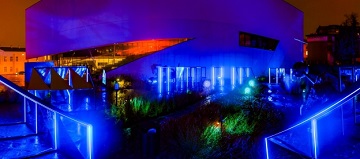Other events in Baltic States
International Internet Magazine. Baltic States news & analytics
Thursday, 08.01.2026, 19:49
MO Museum in Vilnius Creates Outdoor Installation to Inspire Citizens
 Print version
Print version |
|---|
When the global pandemic caused massive shutdowns, artists and museums were forced to find new ways to display their pieces and invite people to experience art in a safe way. MO Museum in Vilnius, Lithuania, decided to bring the art outside to soothe and inspire citizens.
Today Lithuanian lockdown restrictions are enforced once again to contain the spread of the pandemic. While museums are still closed off for the public, Vilnius, the capital of Lithuania, continues to prove that art can exist and find its viewers outside the walls of the galleries.
Vilnius' MO Museum's latest piece "The Art of Feeling Christmas", an outdoor art installation created with the safety of visitors in mind, is an invitation to create brighter holiday anticipation in response to the gloomy mood during the pandemic. The installation is based on the idea of reflections, following the architecture of the museum building, designed by Daniel Libeskind.
"The current fight that we all are in requires solidarity and just a glimmer of light and inspiration. For this, we used MO architecture and its outdoor space. The lights and reflections not only create a quiet and calm Christmas mood but also give a reason to slow down, listen to yourself and feel the miracle of holiday anticipation. It is best to experience the festive atmosphere by yourself, without any rush or big gatherings.", says Milda Ivanauskienė, director of MO Museum.
Because most of us are bound to stay indoors, MO Museum's staff shares the photos of the installation online. Until the end of the holidays, various artists will send their video greetings with original music and dance performances, as well as verbal greetings that will be available on MO's website.
MO Museum opened its doors in 2018 as a personal initiative of Lithuanian scientists and philanthropists Danguolė and Viktoras Butkus. This year MO was nominated for European Museum of the Year Award and continues to focus on popularizing art by building a strong connection with its audience.
"Reflections not only create a visual impression but the metaphorical meaning, too: they enable you to see yourself from different angles and can give you a new perspective," explains Ivanauskienė.
The journey through "The Art of Feeling Christmas'' begins with a mirrored tunnel where the visitors can observe themselves from various angles. The piece then continues with the museum's stairs, transformed into a snowy hill challenge, that ends in a charming terrace. The installation was created to be a therapeutic experience to help visitors leave anxiety, hurry, and bad thoughts behind. As if in a fairy tale or a myth, the adventure transforms viewers into active characters who will set out on a manifold journey: from the state of confusion, wandering, and inability to find peace to people who find emotional eminence, positivity, and revival. To ensure everyone's safety and not violate the current quarantine requirements, the museum encourages people to experience the installation individually or with the closest members of the family.
"The Art of Feeling Christmas" is a continuation of MO Museum's plans to bring the art closer to the viewers. The museum has been closed off for the visitors since November 7th. Despite that, during the quarantine, MO moved "Why Is It Hard to Love?" exhibition, curated by Saskia Boddeke and Peter Greenaway, outside, making it available for every citizen for free. All of the museum's events as well as educational sessions are now held online and can be accessed by every art lover, even if they live outside Vilnius.
MO museums latest installations are a reflection of the city's efforts to keep art alive – this summer Vilnius has announced the plan to turn the city into an open-air museum. The "Art Needs No Roof" initiative brought 100 works of local art outside, displayed throughout the city using billboards. A virtual map was set up to navigate through the exhibition, read about the art objects, while the citizens and city guests were encouraged to visit the pieces in real life. Every piece of the exhibition was for sale, helping the artists recover after the unexpected crisis.









 «The Baltic Course» Is Sold and Stays in Business!
«The Baltic Course» Is Sold and Stays in Business!

